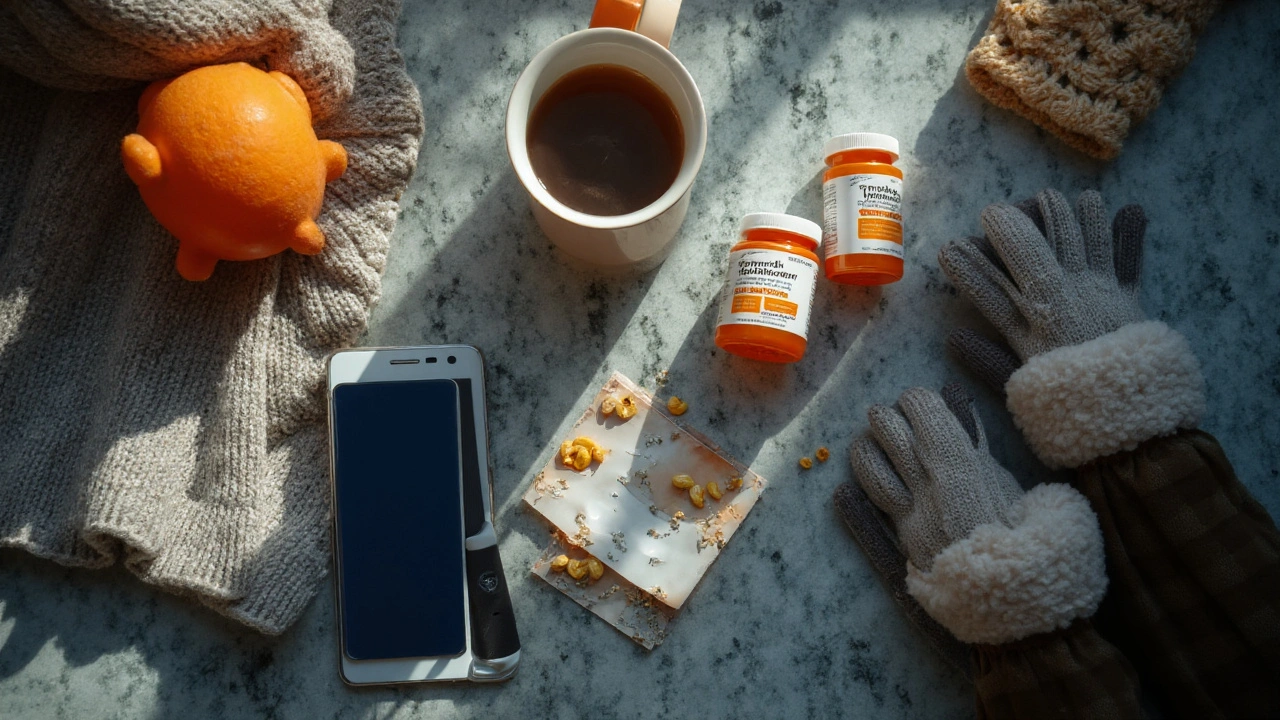Amlodipine for Raynaud’s: Can It Improve Blood Flow and Cold Hands?
 Aug, 25 2025
Aug, 25 2025
Cold, painful fingers that turn white or blue aren’t just annoying-they can stop you doing everyday things like texting, buttoning a shirt, or cycling to work on a frosty Bristol morning. The big question: can amlodipine make Raynaud’s attacks less frequent and less brutal? Short answer: often yes, but it’s not a cure-all and it won’t work overnight.
- TL;DR: Amlodipine (a calcium channel blocker) can reduce how often and how severe Raynaud’s attacks are for many people, especially in primary Raynaud’s.
- First choice in the UK is usually nifedipine, but amlodipine is a solid alternative if you can’t tolerate it or prefer once-daily dosing.
- Typical dosing: start 5 mg daily, review after 2-4 weeks, consider 10 mg if needed and tolerated.
- Common side effects: ankle swelling, flushing, headache, palpitations. Serious issues are uncommon but watch for dizziness or worsening swelling.
- If attacks are severe (e.g., ulcers, very painful, or linked to scleroderma), you’ll likely need more than one treatment-sometimes specialist therapies.
How amlodipine helps Raynaud’s-and who should consider it
Raynaud’s is a spasm of the small blood vessels in fingers and toes triggered by cold or stress. Blood flow drops, digits go white then blue, and as flow returns they can flush red and throb. The goal is simple: keep vessels relaxed and open more often to prevent that cascade.
Amlodipine is a dihydropyridine calcium channel blocker (same family as nifedipine). It relaxes the smooth muscle in blood vessel walls, which lowers resistance and improves flow to the periphery. In hypertension and angina, that means lower blood pressure and better cardiac oxygen delivery. For Raynaud’s, the win is warmer, less reactive fingers.
What does the evidence say? A Cochrane review of calcium channel blockers for primary Raynaud’s (2016) shows a modest but real benefit-on average, about 1-3 fewer attacks per week versus placebo, mostly driven by nifedipine data. Amlodipine has fewer randomized trials but shows similar direction of effect in smaller studies and routine care. European (EULAR) recommendations for systemic sclerosis-related Raynaud’s place oral dihydropyridines as first-line; UK guidance (NICE/CKS; BNF) routinely lists nifedipine first, with amlodipine as a practical alternative.
Who’s a good candidate?
- Primary Raynaud’s with frequent or painful attacks despite warm clothing and trigger control.
- People who couldn’t tolerate nifedipine (e.g., headaches) or want once-daily dosing with steadier levels.
- Secondary Raynaud’s (e.g., in scleroderma) as part of a broader plan-though you might need add-on therapies if ulcers or severe ischemia are a problem.
Who should be cautious?
- Very low baseline blood pressure or symptomatic dizziness.
- Significant ankle swelling tendency or heart failure with fluid overload.
- On specific interacting meds (notably high-dose simvastatin-you may need dose adjustment).
What to expect: improvement is gradual. Give it 2-4 weeks at a starting dose before judging. If attacks remain frequent, many people benefit from gently stepping up the dose. If nothing changes after a fair trial (and you’ve nailed the basics like keeping warm), talk to your GP about alternatives or add-ons.
Quick reality check on outcomes: with amlodipine, expect fewer and shorter attacks for many-think “manageable” rather than “gone.” That’s usually enough to get your life back in cold months. If you have red flags like sores on fingertips, nailfold bleeding, or joint/skin changes, you need a rheumatology opinion-medication alone isn’t the whole solution.

How to use amlodipine safely: dosing, timing, side effects, and a practical plan
Here’s a simple, step-by-step way to start amlodipine and give it a fair shot.
- Confirm the basics: primary vs secondary Raynaud’s. If you’ve got features pointing to an autoimmune cause (skin thickening, digital ulcers, rashes, joint swelling, new-onset Raynaud’s after age 30), ask your GP for blood tests and a review before relying on a single drug.
- Start low: 5 mg once daily. Take it at the same time each day. Morning is fine; evening can help if you notice daytime dizziness.
- Give it 2-4 weeks. Track attacks in a simple log: triggers, duration, pain score (0-10), and whether you warmed up faster.
- Adjust if needed: if you’re seeing some benefit but not enough-and side effects are mild-consider 10 mg once daily after discussing with your clinician.
- Reassess each season. Many people step down or stop in warmer months and restart in autumn. Agree a plan with your GP.
Common side effects and what to do:
- Warm flushes, headaches: often settle in 1-2 weeks; hydration and taking the pill at night can help.
- Ankle swelling: raise legs in the evening, consider compression socks. If swelling is persistent or uncomfortable, talk to your doctor-dose reduction or a switch may be better.
- Palpitations or lightheadedness: check sitting and standing blood pressure at home if you can. If you’re dizzy or faint, stop and seek advice.
- Gingival overgrowth (rare with long use): keep up dental hygiene and see your dentist promptly if gums thicken.
Important interactions and cautions (UK focus, 2025):
- Simvastatin: when used with amlodipine, the simvastatin dose should not exceed 20 mg daily (BNF 2025). If you need more LDL lowering, your GP may switch you to atorvastatin or rosuvastatin.
- Strong CYP3A4 inhibitors (e.g., clarithromycin, erythromycin, itraconazole) can raise amlodipine levels and side effects-flag this if starting antibiotics.
- Grapefruit: the interaction is modest compared with other calcium channel blockers, but daily large amounts are best avoided.
- Pregnancy and breastfeeding: nifedipine has the deeper evidence base; amlodipine might still be considered case by case. Always check with your midwife/doctor.
Simple checklist before you start:
- Attacks persist despite warm gloves, layers, hand warmers, and stress control.
- Blood pressure not very low (e.g., not regularly below ~100/60 mmHg with symptoms).
- No current ankle swelling that limits shoes or movement.
- No recent start of interacting medicines.
- Plan for a review in 2-4 weeks and a winter strategy.
Decision rule of thumb (not a diagnosis):
- Fewer than 2 attacks per week and mild? Keep up non-drug measures. Consider medication only if function is affected.
- 2+ attacks per week, painful or prolonged? Trial a dihydropyridine. If nifedipine caused headaches or is impractical, amlodipine is reasonable.
- Ulcers, severe pain, or suspected autoimmune features? Seek specialist input early; you may need combination therapy.
Evidence notes worth knowing (why your GP might prefer one over another):
- Cochrane 2016 (primary Raynaud’s): modest reduction in attack frequency with calcium channel blockers; nifedipine dominates the data.
- EULAR recommendations (systemic sclerosis): start with oral dihydropyridines; consider PDE‑5 inhibitors (e.g., sildenafil) and IV iloprost for severe disease; bosentan helps prevent new digital ulcers.
- NICE CKS/BNF: list nifedipine modified-release as first-line; amlodipine is an accepted alternative in UK practice when nifedipine isn’t tolerated or preferred.
Mini-FAQ (quick hits):
- How fast does it work? Expect the first meaningful change after 1-2 weeks; full effect by 4 weeks.
- Can I take it only on cold days? It works best taken daily through the cold season, not “as needed.”
- Will it raise my heart rate? Mild increases can happen, but many people feel no change.
- Can athletes use it? Yes, but monitor blood pressure and dizziness, especially with endurance training.
- Is it safe long term? Generally yes with routine checks; review each season and adjust.

Alternatives, add-ons, comparisons, and real-world tips that actually help
Medication is just one lever. Warming strategy plus stress control often multiplies the benefit. When you need drugs, it helps to see how options compare.
| Option | Typical UK dose | Evidence for attack reduction | Common issues | Notes |
|---|---|---|---|---|
| Amlodipine | 5-10 mg once daily | Moderate evidence; fewer RCTs than nifedipine; many patients report fewer/shorter attacks | Headache, flushing, ankle swelling | Steady once-daily dosing; good for adherence |
| Nifedipine MR | 10-40 mg twice daily (varies by product) | Best studied; Cochrane shows ~1-3 fewer attacks/week vs placebo | Headache, flushing, ankle swelling | Often UK first-line; MR forms better tolerated than immediate-release |
| Sildenafil (PDE‑5) | 20-50 mg 2-3 times daily | Helpful for severity and healing in secondary Raynaud’s | Headache, flushing, dyspepsia | Consider if CCB alone insufficient; watch interactions |
| Topical glyceryl trinitrate | Small amount to fingers before cold exposure | Short-term perfusion boost | Local irritation, headache | Useful for targeted tasks outdoors |
| IV Iloprost | Specialist infusion | For severe ischemia/ulcers | Headache, flushing; requires hospital | Rheumatology-led escalation |
Non-drug tactics that punch above their weight:
- Pre-warm routine: warm water on hands, glove liners, then insulated gloves. Battery hand warmers in coat pockets for bus stops and football terraces.
- Layer like you mean it: thermal base layer, windproof outer, warm socks plus lined boots. Keep your core warm to protect your fingers.
- Grip the triggers: avoid sudden cold (freezers, metal steering wheels), handle stress (breathing drills, micro-breaks), and keep caffeine moderate if it seems to set you off.
- Plan cold jobs: batch freezer tasks, carry a warm flask, park closer, warm the car. Small planning beats one big shiver.
Realistic scenarios and what usually works best:
- Primary Raynaud’s, student cyclist, 21, lots of exam stress: start with strong warming tactics; if attacks remain frequent, try amlodipine 5 mg in winter. Review before spring.
- Office worker, 45, migraines on nifedipine: switch to amlodipine 5 mg; many find headaches settle, with similar Raynaud’s control.
- Barista, 32, freezer exposure: add topical nitro for shifts; keep amlodipine daily in winter; wear insulated fingerless gloves behind the bar.
- Scleroderma-related Raynaud’s with fingertip ulcers: CCB plus PDE‑5 inhibitor; consider IV iloprost via rheumatology; protect digits aggressively.
Pitfalls to avoid:
- Stopping after 3 days: give it 2-4 weeks unless side effects are rough.
- Ignoring swelling: persistent ankle oedema is not a badge of honour-ask for a dose tweak or alternative.
- Chasing perfection: the goal is fewer, shorter, less painful attacks; total elimination is rare.
- Going it alone with ulcers or new autoimmune signs: that needs specialist input fast.
Q&A you’ll likely ask next:
- Can I combine amlodipine with nifedipine? Usually no-same class, more side effects for little extra gain. Combine with a different class if needed.
- What about beta‑blockers? Some can worsen Raynaud’s; if you need one, ask about more peripheral‑friendly options.
- Is there a best time of year to start? Early autumn in the UK, before the first cold snap, is smart.
- Will weight training help? Yes-better circulation and warmer baseline can reduce attacks.
- Does smoking matter? Massively. Nicotine constricts vessels; quitting often helps more than any pill.
Next steps and troubleshooting (pick your path):
- Mild, seasonal symptoms: double down on warming strategies; keep a rescue plan (topical nitro) for outdoor days. Consider amlodipine only if function suffers.
- Moderate, frequent attacks: start 5 mg amlodipine; reassess in 2-4 weeks; increase to 10 mg if partial response and well tolerated. Keep a symptom log.
- Persistent despite 10 mg or not tolerated: switch to nifedipine MR or add a different class (e.g., PDE‑5) after clinician review.
- Severe disease or ulcers: urgent GP/rheumatology review for combination therapy and protective care.
- Low blood pressure/dizziness: try night dosing, hydrate, and consider dose reduction or alternative.
- Pregnant or planning: review with your clinician; nifedipine has more pregnancy data. Do not self-adjust without advice.
Safety note: This article is for general information, not personal medical advice. For dosing, interactions, and diagnoses, speak with your GP or pharmacist. Key references include the Cochrane Review on calcium channel blockers for Raynaud’s (2016), EULAR recommendations for systemic sclerosis-related Raynaud’s, and UK resources such as NICE Clinical Knowledge Summaries and the BNF (2025).
If you’re weighing amlodipine right now, set a simple plan: start low, track results, warm up smart, and book a check-in. With that approach, winter hands can be a lot less miserable.

Rekha Tiwari
August 31, 2025 AT 22:54I started amlodipine last winter after my fingers turned purple while making coffee 🥶 Turns out, it didn't fix everything but made the difference between crying in the shower and just grumbling while wearing three pairs of gloves. Still get attacks but now I can text without holding my hands under my armpits. Worth it.
Leah Beazy
September 1, 2025 AT 21:02OMG YES. I was skeptical but my GP said try it for 4 weeks. Day 3: still freezing. Day 14: I held my kid's hand without wincing. Day 28: I rode my bike to work in November. I didn't think that was possible anymore. Also, the ankle swelling? Real. But I wear compression socks now and it's fine. 10/10 would recommend if you're tired of being a human ice cube.
John Villamayor
September 2, 2025 AT 20:33Jenna Hobbs
September 4, 2025 AT 20:11Y'ALL. I have scleroderma and my fingers used to look like frozen sausages. I was on nifedipine but the headaches were brutal. Switched to amlodipine 5mg and it was like someone flipped a switch. I can button my coat again. I can hold a coffee mug without screaming. I cried the first time I typed without gloves. This isn't magic but it's the closest thing I've found to a gift. Thank you for writing this.
Ophelia Q
September 6, 2025 AT 09:44Just wanted to say thank you for the checklist. I didn’t realize I was ignoring the basics-like warming my core first. I started wearing a heated vest under my coat and now my hands stay warmer even before I take the pill. Small changes matter. Also, the ankle swelling tip? Lifesaver. Compression socks are my new best friend.
Elliott Jackson
September 6, 2025 AT 19:03Look I get it, people love this drug but have you tried just… not being cold? Like maybe the real solution is moving to Florida or wearing 17 layers? I’ve seen people on here acting like amlodipine is some miracle cure when it’s just a vasodilator with side effects. Also I’ve had Raynaud’s for 15 years and I’ve never needed meds. Just wear gloves. Problem solved. 🤷♂️
McKayla Carda
September 7, 2025 AT 15:20For anyone considering this: start at 5mg. Don’t rush to 10mg. Give it time. And if your ankles swell, don’t ignore it. I thought it was just water weight until I couldn’t fit into my boots. Dropped back to 5mg and it cleared up. Also, take it at night. Less flushing.
Christopher Ramsbottom-Isherwood
September 8, 2025 AT 19:17Interesting that you mention nifedipine as first-line. That’s purely a UK thing. In the US, amlodipine is often first for hypertension, so it’s no surprise it’s used here too. But the Cochrane review is mostly nifedipine data. You’re essentially extrapolating. Also, the ‘steady dosing’ argument? That’s just marketing. The half-lives are similar. Nifedipine MR is just more studied. Don’t oversell it.
Stacy Reed
September 10, 2025 AT 15:06I’ve been thinking… is Raynaud’s really just a symptom of modern life? We’re so disconnected from nature, we live in climate-controlled boxes, then we go out into freezing air and expect our bodies to adapt. Maybe the real fix is to stop treating our bodies like machines and start listening to them. I stopped taking meds and started doing cold showers. My hands are warmer now. Maybe we’re overmedicalizing a natural response.
Robert Gallagher
September 10, 2025 AT 22:14I’ve been on amlodipine for two winters now. Started at 5mg, moved to 10mg after the first season. I’m a runner. I used to have to stop mid-run because my fingers locked up. Now? I can run in 30-degree weather with just thin gloves. I don’t take it in summer. I just restart in October. Simple. Also, side effects? Mild headache for the first week, then gone. Ankle swelling? Yeah, but I’m 6’3” and I lift heavy. So maybe it’s not all the drug. Point is: it works. Don’t overthink it.
Howard Lee
September 12, 2025 AT 09:46Correction: the BNF 2025 states that amlodipine is an alternative to nifedipine, not an equivalent. The evidence base for nifedipine remains stronger, particularly in randomized trials. Additionally, the interaction with simvastatin is not merely a dose limitation-it’s a contraindication above 20 mg. Please ensure accuracy in referencing guidelines.
Nicole Carpentier
September 13, 2025 AT 16:54I’m a barista and I used to have to take breaks every 20 minutes because my fingers turned blue near the freezer. Tried amlodipine + fingerless insulated gloves + hand warmers in my pockets. Now I can work a whole shift without stopping. Also, I take it at night so I don’t feel weird during the day. And yes, I still get cold. But now I’m not terrified of winter anymore. 🙌
Hadrian D'Souza
September 13, 2025 AT 22:48Oh wow, another person treating a calcium channel blocker like a spiritual awakening. Let me guess-you also meditate, drink bone broth, and believe in ‘energy healing’? This isn’t magic. It’s pharmacology. You’re not ‘cured.’ You’re just less symptomatic. And if you’re praising this like it’s the second coming, you probably also think vitamin C cures COVID. Chill. It’s a drug. Take it. Don’t turn it into a lifestyle brand.
Brandon Benzi
September 15, 2025 AT 10:39Why are we letting the UK dictate our meds? Nifedipine is the gold standard. Amlodipine is just cheaper and easier to prescribe. You think this is science? It’s corporate convenience. Also, why are you all so obsessed with winter? Move to Texas. Problem solved. We don’t need drugs for cold hands. We need better geography.
Abhay Chitnis
September 15, 2025 AT 16:35My cousin in Mumbai has Raynaud’s and he uses amlodipine too. He says it works but the swelling is worse in humid weather. Also, he doesn’t take it in summer. Same as here. Funny how the same drug works the same way across continents. Maybe it’s not magic after all. Also, I use a hand warmer app now. Helps me remember to move my fingers. 😎